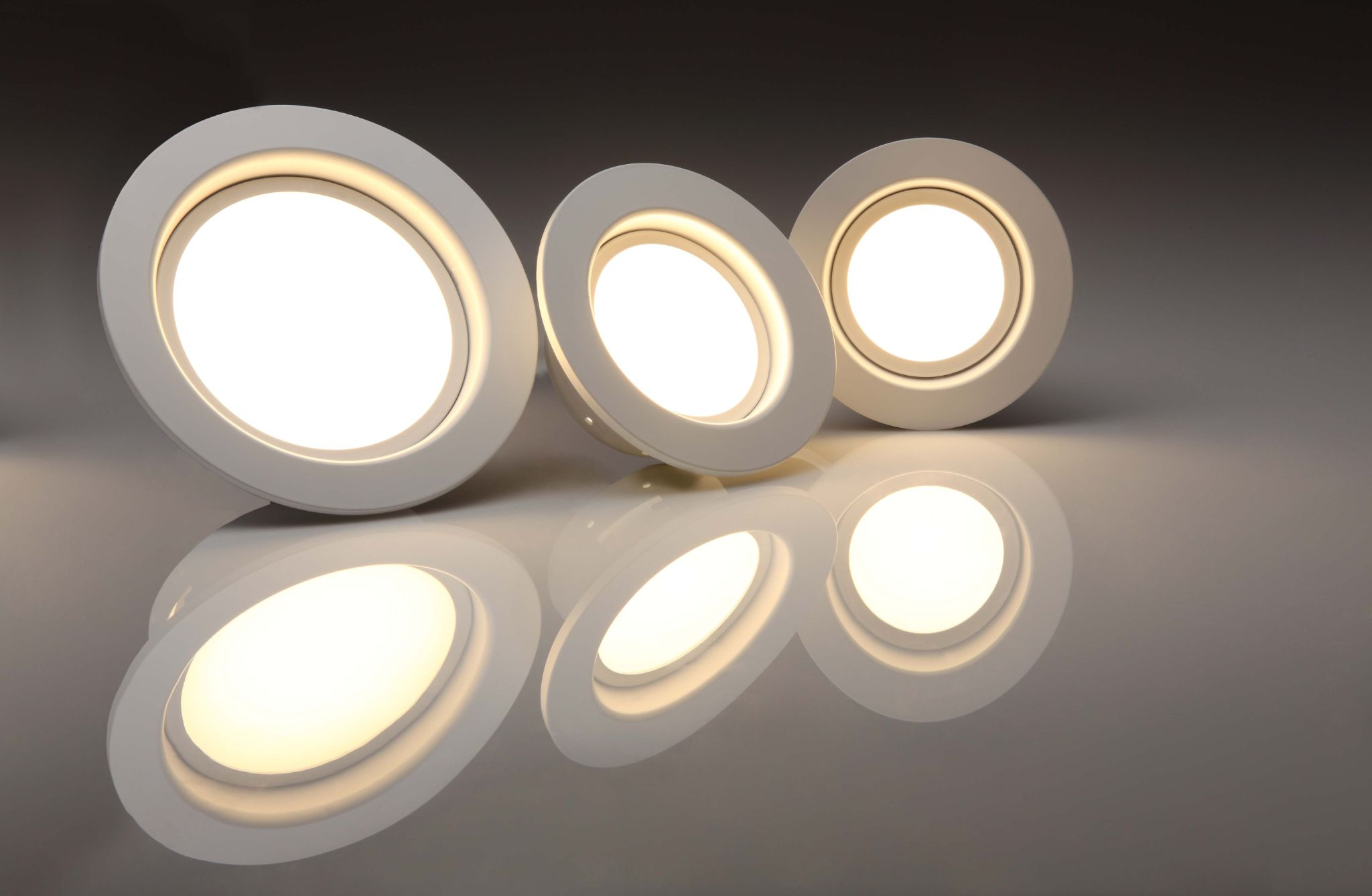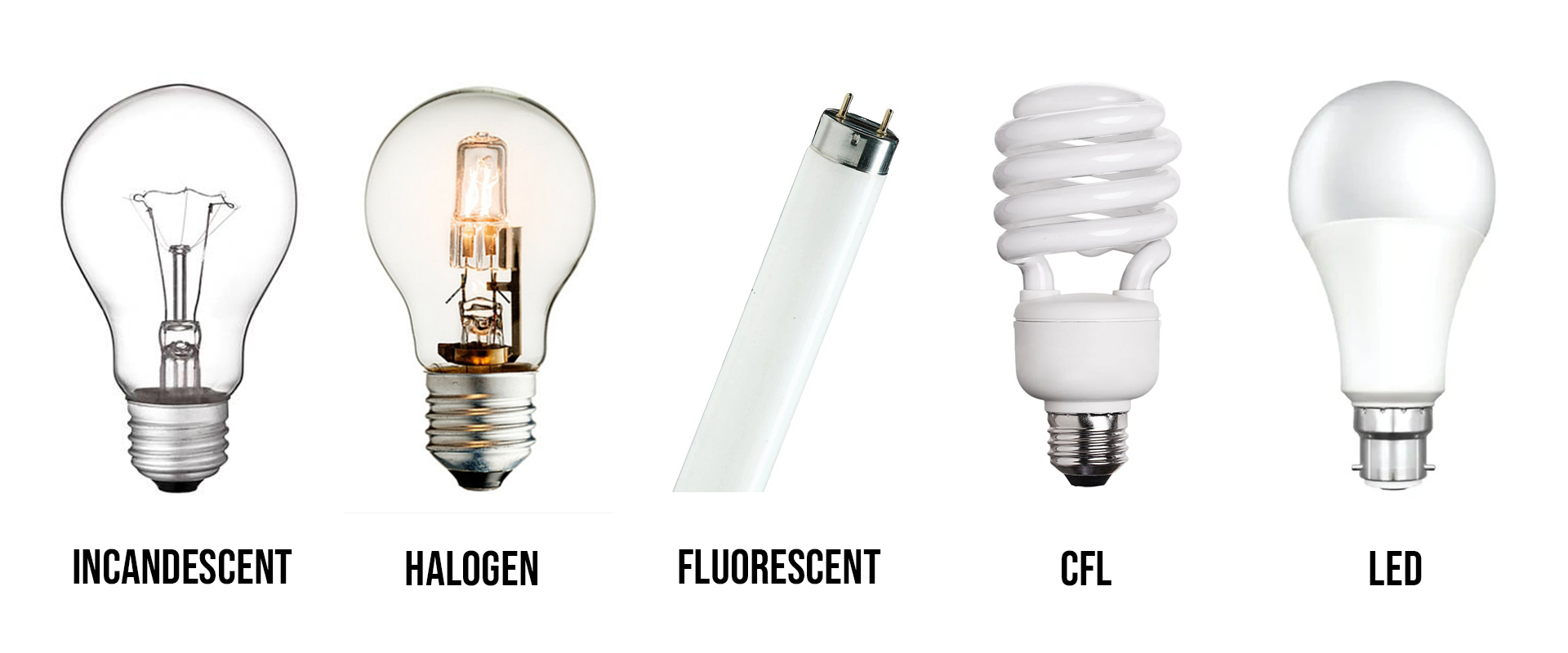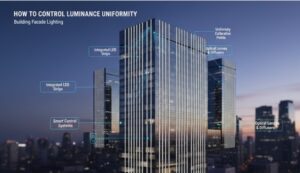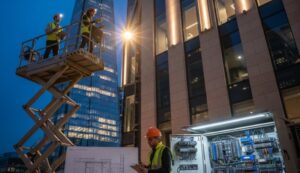In an era marked by a growing emphasis on sustainability and energy conservation, businesses increasingly turn to LED lighting as a smart and eco-friendly choice. This revolutionary technology offers many benefits ranging from cost reduction to greater longevity.
In this article, we explore the mass appeal of LED lighting, its cost advantages for businesses, and why you shouldn’t miss out on these savings.
Why Choose Modern LED Lighting for Your Business?

LED, short for light emitting diode, is a semiconductor device that generates light photons when exposed to an electric current. LED lighting combines these diodes with small control circuits to create light fixtures (luminaires) in various sizes and shapes.
Modern LED lighting systems are incredibly energy efficient and are widely used in business applications where power savings are heavily prioritized.
LED lights provide clean and non-intrusive aesthetics in domestic lighting like house interiors. And in commercial LED lighting setups, you can expect a wider coverage area while consuming less power than traditional solutions.
Energy Cost Savings with LED Lighting

Let’s break down the total cost of running traditional light bulbs in a business for a whole year.
First, we take a standard 700 lumens of illumination as our testing standard. An incandescent bulb will use 60W of power to reach this level, a halogen – 45W, a CFL – 15W, and a LED – 10W.
An average business runs for 8 hrs a day, 260 days a year. So the average runtime of a bulb is 2,080 hours/year. We can calculate the total kilowatt-hours (kWh) consumed by multiplying the Bulb Wattage with the total Annual Hours and dividing by 1000.
Annual Power Consumption = Bulb Wattage x Hours /1000
Then we multiply the current electricity cost in your area and multiply the two numbers. As of February 2023, electricity in the US costs, on average, 23 cents per kilowatt-hour.
| Lighting Tech. | Bulb Wattage | Daily Use Hours | Annual Power Consumption | Electricity Costs(Cents per kWh) | Annual Power Costs($USD) |
| Incandescent | 60W | 2080 hours | 124.8 kWh | 23¢/kWh | $28.70 |
| Halogen | 45W | 2080 hours | 93.6 kWh | 23¢/kWh | $21.52 |
| Fluorescents | 15W | 2080 hours | 31.2 kWh | 23¢/kWh | $7.18 |
| LED | 10W | 2080 hours | 20.8 kWh | 23¢/kWh | $4.78 |
Following our simple calculation, we can surmise that the energy savings of LED lights are $24 (28.70-4.78) per bulb per year. Large commercial LED lighting setups such as factory, warehouse, and parking garage lighting have hundreds of light bulbs (fixtures).
Meaning the cost savings will jump up to thousands of dollars each year. But the savings don’t end with electricity bills. Another great benefit of LED lighting is its reduced maintenance costs.
Maintenance Cost Savings
Lighting costs increase significantly over time if your account for the replacement bulbs. Over ten years, you are expected to replace your incandescent bulbs 10-15 times, compared to one LED replacement per year.
Let’s take our four light bulbs with an approximate output of 500 lumens and compare their cost after ten years of maintenance/replacement. Prices shown are averages taken from several manufacturers as of February 2023.
| Bulb Tech. | Cost500 Lumens | Life Span | Annual Run Time | Replacement Time | Cost After 10 Years |
| Incandescent60W | $1.30 | 1,000 hrs | 2,080 hrs | 6 months | $26 |
| Halogen45W | $1.40 | 2,000 hrs | 2,080 hrs | 1 year | $14 |
| CFL13W | $2.30 | 8,000 hrs | 2,080 hrs | 4 years | $5.75 |
| LED10W | $2 | 25,000 hrs | 2,080 hrs | 10 years | $4 |
Hence, if you stick with incandescent bulbs for 10 years, the maintenance cost of replacing burnt-out bulbs will be five to six times higher than LED bulbs. Again this cost will scale with the number of older incandescent bulbs deployed in a given business.
Lifespan is just one metric. Traditional bulbs with their glass exterior are also prone to impact damage. Hence you may have to replace them more often.
Finally, it should be noted that prices shown here will vary from manufacturer to manufacturer. Vintage incandescent bulbs are often more expensive than LEDs due to their novel design compared to modern lighting.
As LEDs become the predominant lighting solution, traditional light bulbs will become harder and harder to get and sell for several times their original value.
Real-life Examples of Business Saving Millions in Energy Costs

So far, we have discussed the hypothetical savings of LEDs over other traditional lighting options. But several businesses worldwide have already implemented this change and are benefiting substantial yearly savings.
- Starbucks has adopted LED lighting in the US for its nearly 16,000 locations. The switch from CFLs to LEDs has resulted in an estimated savings of $4 million each year for the coffeehouse franchise.
- Similarly, UK clothing retailer Marks & Spencer has shifted to 100% use of LED lights in their nearly 100 stores in Britain. They were saving at least 1.5 million each year compared to traditional lights.
The above examples were of businesses going from CFLs to LEDs. And for businesses shifting from the much older incandescent light bulbs, the savings will be even greater.
How is LED Lighting Different from Traditional Lighting Solutions?

Traditional lighting options (incandescent, halogen, and fluorescent bulbs) work by blasting a thin tungsten wire (called a filament) with a high-voltage electric current. The current heats the tungsten filament causing it to glow.
Light generation through heat is a very inefficient process. Nearly all the electric power from traditional light bulbs gets converted into heat energy. LEDs, by comparison, generate light by illuminating semiconductor matter through electric current.
Semiconductors offer a more direct electricity-to-light conversion, which comes with its own set of benefits.
7 Key Benefits of LED Lighting in Business
We covered the basics of LED light bulbs, but it’s time to dive deep into the details. Energy-efficient lighting has several perks that will significantly impact your buying decision.
| Lighting Technology | Incandescent | Halogen | Fluorescents | LED |
| Lumens per Watt | 14 | 20 | 60 | 75 |
| Cost | Low | Low | Medium | Medium |
| Size | Medium | Medium | Large | Very Small |
| Energy Efficiency | Very Low | Low | High | Very High |
| Life Span | 1,000 hrs. | 2,000 hrs. | 10,000 hrs. | 25,000 hrs. |
| Durability | Fragile | Fragile | Fragile | Robust |
| Environmental Impact | High | High | Medium | Low |
| Design Versatility | Low | Low | Medium | High |
| Color Accuracy | Medium | Medium | Low | High |
| Cooling Costs | High | High | Low | Low |
1 – Energy Efficiency
Studies have shown the real-life impact of energy efficiency and the improvements provided by LED lights.
- Incandescent bulbs are the least efficient solution, with only 10% of the electricity being converted to light.
- Halogen bulbs are slightly improved over incandescent, consuming, on average, 20-30% less power for the same luminance level.
- Fluorescents provide the next big jump in efficiency by ditching the old tungsten filaments for mercury vapor. These bulbs can hit up to 80% energy efficiency but at the cost of using toxic mercury.
- CFLs (compact fluorescent lights) are a refined version of fluorescent technology, providing significant size reduction for the sale level of illumination.
- LED light bulbs are the culmination of over 100 years of lighting research and the advancements of semiconductors. Today you will see LED lights are 90% energy efficient and at a fraction of the size.
2 – Life Span
The initial cost of a LED light bulb is higher than an incandescent bulb. However, incandescent bulbs are typically only rated for 1,000 hours of use. Compared to the massive 25,000 to 50,000 hours of LED light bulbs.
Replacement bulbs will cost a business owner much more in the long term than simply switching to LED bulbs.
3 – Durability
Traditional lighting options are fragile due to their glass and quartz-based enclosures. Even the slightest impact can shatter CFL and incandescent bulbs.
LED lights, by comparison, are very robust. The diodes are lightweight, shockproof, and typically housed in flexible and heat-resistant PMMA (Polymethyl methacrylate).
Hence, like lifespan, poor durability will lead to higher business maintenance costs.
4 – Environmental Impact
LED lights provide energy savings to the consumer and a safer environment for everyone. Our reliance on excessive electric power has put a strain on the environment.
We are outputting more heat into the atmosphere every year. Reducing energy consumption and increasing LED lights’ lifespan has decreased businesses’ carbon footprint.
5 – Versatile Design
LED lights’ small and compact size lends them to various styles and designs that would otherwise be impossible with traditional lighting.
Strip lights, compact accent lights, and underwater pool lighting are all made possible due to the unique features of LED lights. Today you can customize your business lighting options using LEDs of any shape and size you desire and with a wide range of power (Brightness) options.
6 – Color Accuracy
CRI, or Color Rendering Index, measures the color accuracy of an object under artificial light. A CRI of 100 means the object’s color displayed under a light bulb matches its appearance under natural daylight.
All LED bulbs output light at a high CRI of 80-90. With Quality LED light bulbs easily hitting the ideal 100 CRI mark. A higher CRI is often necessary for task lighting in offices.
Traditional bulbs emit light in the warmer region, which has a high CRI but struggles with the shades of blue, leading to poor color accuracy.
7 – Additional Savings
Let’s talk about the indirect benefits of lower energy use. Higher power consumption leads to more heat, which requires more power in air conditioning.
LED lights save money through direct lower electricity consumption. But also indirectly through cooling costs.
Another means of indirect savings from LEDs comes from directional lighting. Traditional light bulbs are unidirectional and waste energy lighting the wanted surrounding areas.
Conclusion
Commercial LED lighting has become the go-to choice for new businesses. The energy savings alone make LED lights a must-have solution. Also, a close inspection of the technology reveals several other equally vital benefits, such as reduced cooling costs, compact size, and longer life.
Switching to LED lighting will yield immediate positive results for businesses by reducing their ongoing electricity bills. In the long term, businesses will see additional savings from reduced maintenance and cooling costs.
Discover the Perfect Solution for Your Business with RC Lighting
RC Lighting is an industry-leading expert in LED lighting design. We have been manufacturing high-quality premium LED products for over 20 years.
Our expert technical staff carefully and diligently oversee the production of our ISO & IP-certified LED lighting products to ensure you get the very best in LED technology.
At RC Lighting, we understand our products’ impact on your business. We aim to help make your business an even bigger success using our LED lights.
So, what are you waiting for? Get started with our REE project evaluations.



